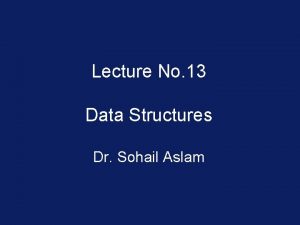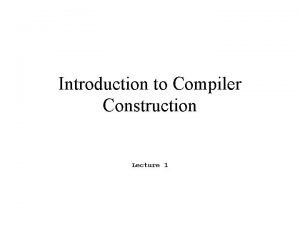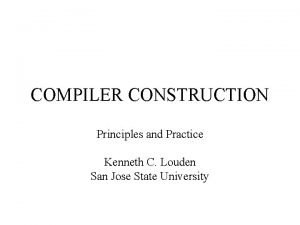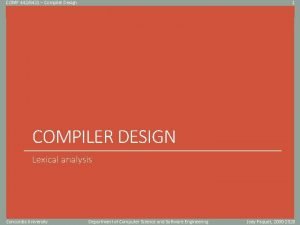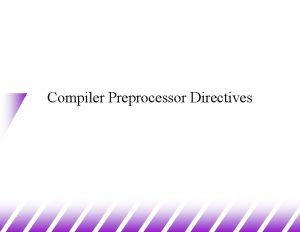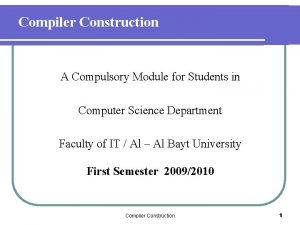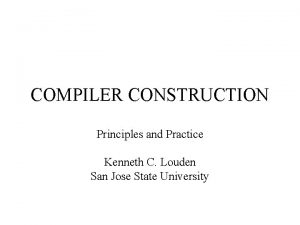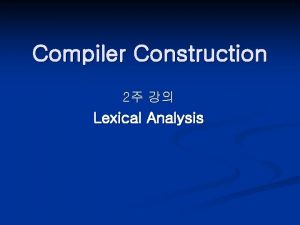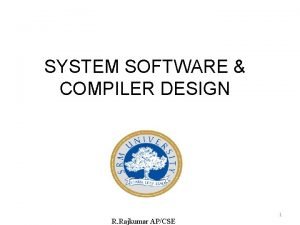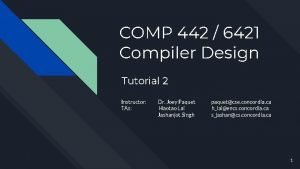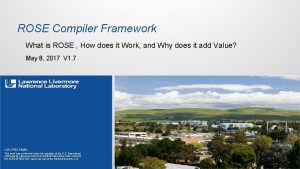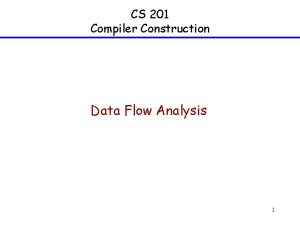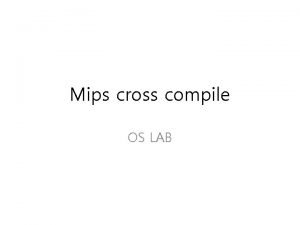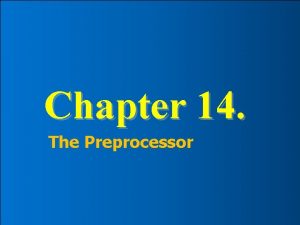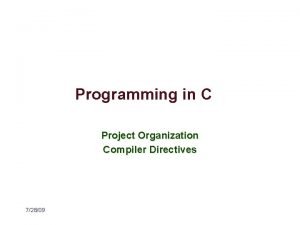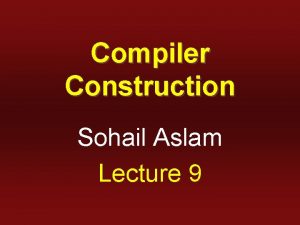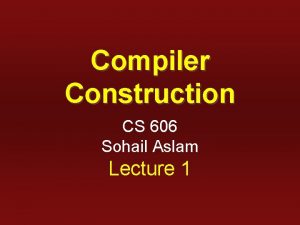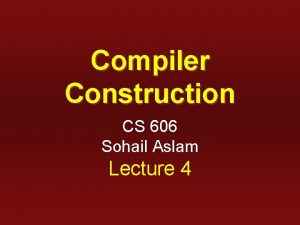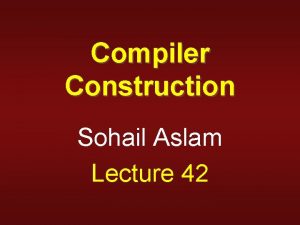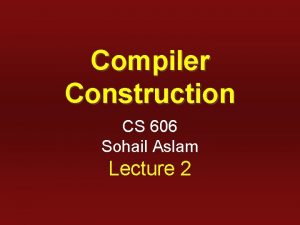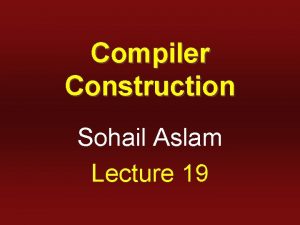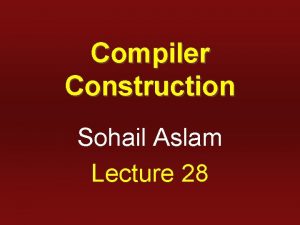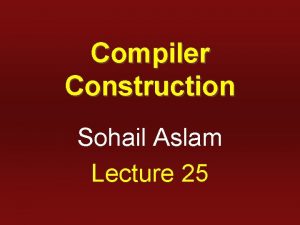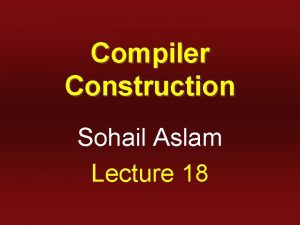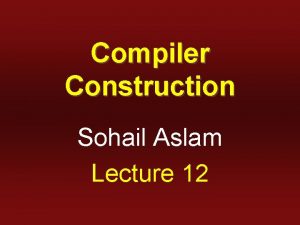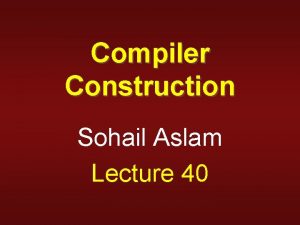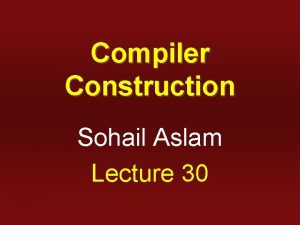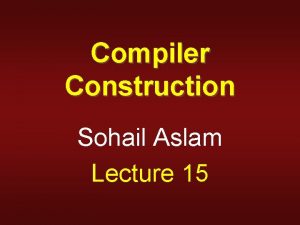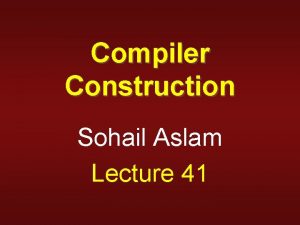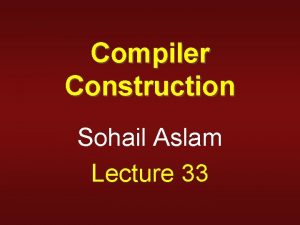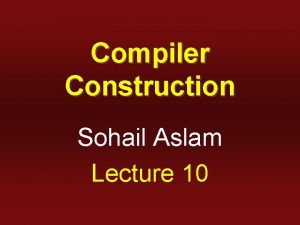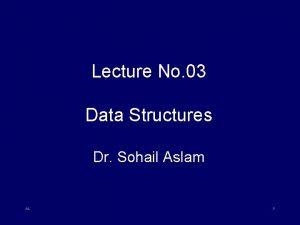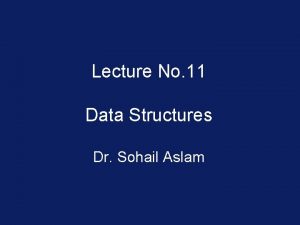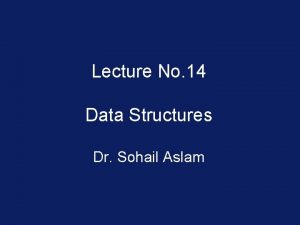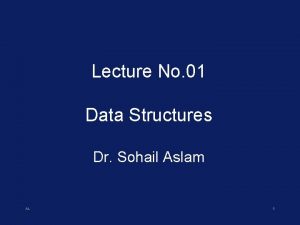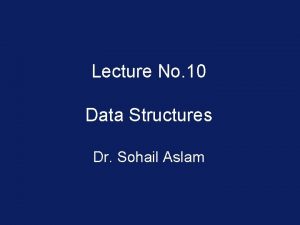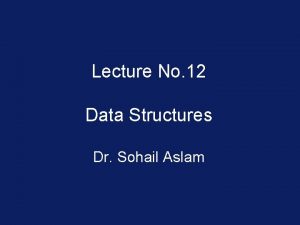Compiler Construction Sohail Aslam Lecture 6 How to










![RE Extentions [abc] = a|b|c (any of listed) [a-z] = a|b|. . |z (range) RE Extentions [abc] = a|b|c (any of listed) [a-z] = a|b|. . |z (range)](https://slidetodoc.com/presentation_image/4a30859c4a8506b48769baad88bf98d0/image-11.jpg)
















- Slides: 27

Compiler Construction Sohail Aslam Lecture 6

How to Describe Tokens? § Regular Languages are the most popular for specifying tokens • Simple and useful theory • Easy to understand • Efficient implementations 2

Languages § Let S be a set of characters. S is called the alphabet. § A language over S is set of strings of characters drawn from S. 3

Example of Languages Alphabet = English characters Language = English sentences Alphabet = ASCII Language = C++ programs, Java, C# 4

Notation § Languages are sets of strings (finite sequence of characters) § Need some notation for specifying which sets we want 5

Notation § For lexical analysis we care about regular languages. § Regular languages can be described using regular expressions. 6

Regular Languages § Each regular expression is a notation for a regular language (a set of words). § If A is a regular expression, we write L(A) to refer to language denoted by A. 7

Regular Expression § A regular expression (RE) is defined inductively a ordinary character from S e the empty string 8

Regular Expression R|S RS R* = either R or S = R followed by S (concatenation) = concatenation of R zero or more times (R*= e |R|RR|RRR. . . ) 9

RE Extentions R? R+ (R) = e | R (zero or one R) = RR* (one or more R) = R (grouping) 10
![RE Extentions abc abc any of listed az ab z range RE Extentions [abc] = a|b|c (any of listed) [a-z] = a|b|. . |z (range)](https://slidetodoc.com/presentation_image/4a30859c4a8506b48769baad88bf98d0/image-11.jpg)
RE Extentions [abc] = a|b|c (any of listed) [a-z] = a|b|. . |z (range) [^ab] = c|d|. . . (anything but ‘a’‘b’) 11

Regular Expression RE Strings in L(R) a “a” ab “ab” a|b “a” “b” (ab)* “” “abab”. . . (a|e)b “ab” “b” 12

Example: integers § integer: a non-empty string of digits § digit = ‘ 0’|’ 1’|’ 2’|’ 3’|’ 4’| ’ 5’|’ 6’|’ 7’|’ 8’|’ 9’ § integer = digit* 13

Example: identifiers § identifier: string or letters or digits starting with a letter § C identifier: [a-z. A-Z_][a-z. A-Z 0 -9_]* 14

Recap Tokens: strings of characters representing lexical units of programs such as identifiers, numbers, operators. 15

Recap Regular Expressions: concise description of tokens. A regular expression describes a set of strings. 16

Recap Language L(R): set of strings represented by a regular expression R. L(R) is the language denoted by regular expression R. 17

How to Use REs § We need mechanism to determine if an input string w belongs to L(R), the language denoted by regular expression R. 18

Acceptor § Such a mechanism is called an acceptor. input w string language L acceptor yes, if w e L no, if w e L 19

Finite Automata (FA) § Specification: Regular Expressions § Implementation: Finite Automata 20

Finite Automata Finite Automaton consists of § An input alphabet (S) § A set of states § A start (initial) state § A set of transitions § A set of accepting (final) states 21

Finite Automaton State Graphs A state The start state An accepting state 22

Finite Automaton State Graphs a A transition 23

Finite Automata § A finite automaton accepts a string if we can follow transitions labelled with characters in the string from start state to some accepting state. 24

FA Example A FA that accepts only “ 1” 1 25

FA Example § A FA that accepts any number of 1’s followed by a single 0 1 0 26

FA Example § A FA that accepts ab*a § Alphabet: {a, b} b a a 27
 Dr sohail aslam
Dr sohail aslam Dr sohail lectures
Dr sohail lectures Neraca lajur perusahaan aslam
Neraca lajur perusahaan aslam Aslam has to study four books
Aslam has to study four books Aslam anis
Aslam anis Yacc tutorial
Yacc tutorial Cross compiler in compiler design
Cross compiler in compiler design If the lexical analyzer finds a token invalid then?
If the lexical analyzer finds a token invalid then? Compiler construction: principles and practice
Compiler construction: principles and practice Explain front end and back end of compiler
Explain front end and back end of compiler Thompson construction in compiler design
Thompson construction in compiler design Type checker in compiler design
Type checker in compiler design Preprocessor in compiler construction
Preprocessor in compiler construction Phases of compiler construction
Phases of compiler construction Compiler construction: principles and practice
Compiler construction: principles and practice Interpreter in compiler construction
Interpreter in compiler construction Front end and back end in compiler design
Front end and back end in compiler design Lexical analysis
Lexical analysis 01:640:244 lecture notes - lecture 15: plat, idah, farad
01:640:244 lecture notes - lecture 15: plat, idah, farad 4 p's of software project management
4 p's of software project management Software implementation using a pl introduces a new domain
Software implementation using a pl introduces a new domain Compiler design tutorial
Compiler design tutorial Rose compiler
Rose compiler Busy expression in compiler design
Busy expression in compiler design Compiler
Compiler Primo dsl
Primo dsl Directive control examples
Directive control examples Organization of compiler
Organization of compiler
